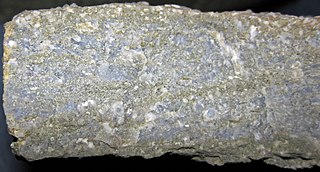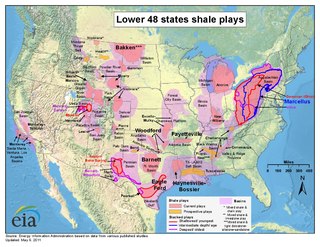
The Fort Payne Formation, or Fort Payne Chert, is a geologic formation found in the southeastern region of the United States. It is a Mississippian Period cherty limestone, that overlies the Chattanooga Shale, and underlies the St. Louis Limestone. To the north, it grades into the siltstone Borden Formation. It preserves fossils dating back to the Carboniferous period.

The Clinton Group is a mapped unit of sedimentary rock found throughout eastern North America. The interval was first defined by the geologist Lardner Vanuxem, who derived the name from the village of Clinton in Oneida County, New York where several well exposed outcrops of these strata can be found. The Clinton Group and its lateral equivalents extend throughout much of the Appalachian Foreland Basin, a major structural and depositional province extending from New York to Alabama. The term has been employed in Kentucky, Maryland, Michigan, New York, Ohio, Pennsylvania, Tennessee, Virginia, and West Virginia, though in many of these areas the same interval is referred to as the Rose Hill, Rockwood, or Red Mountain Formations. Historically the term "Clinton" has also been assigned to several lower Silurian stratigraphic units in Ohio and Kentucky which are now known to be significantly older than the Clinton Group as it was originally defined. Many parts of this succession are richly fossiliferous, making the Clinton Group an important record of marine life during the early Silurian. Several economically valuable rock-types are found within this interval, though it is perhaps best known as a significant source of iron ore
The Devonian Mahantango Formation is a mapped bedrock unit in Pennsylvania, West Virginia, and Maryland. It is named for the North branch of the Mahantango Creek in Perry and Juniata counties in Pennsylvania. It is a member of the Hamilton Group, along with the underlying the Marcellus Formation Shale. South of Tuscarora Mountain in south central Pennsylvania, the lower members of this unit were also mapped as the Montebello Formation. Details of the type section and of stratigraphic nomenclature for this unit as used by the U.S. Geological Survey are available on-line at the National Geologic Map Database.

The Marcellus Formation or the Marcellus Shale is a Middle Devonian age unit of sedimentary rock found in eastern North America. Named for a distinctive outcrop near the village of Marcellus, New York, in the United States, it extends throughout much of the Appalachian Basin.

Shale gas in the United States is an available source of unconventional natural gas. Led by new applications of hydraulic fracturing technology and horizontal drilling, development of new sources of shale gas has offset declines in production from conventional gas reservoirs, and has led to major increases in reserves of U.S. natural gas. Largely due to shale gas discoveries, estimated reserves of natural gas in the United States in 2008 were 35% higher than in 2006.

The New Albany Shale is an organic-rich geologic formation of Devonian and Mississippian age in the Illinois Basin of the United States. It is a major source of hydrocarbons.

The Chagrin Shale is a shale geologic formation in the eastern United States that is approximately 365 million years old. The Chagrin Shale is a gray shale that begins thin and deep underground in north-central Ohio. As it proceeds east, the formation thickens, rises to the surface, and contains greater amounts of siltstone.

The Salem Formation is a geologic formation in Illinois, Indiana, Kentucky, and Missouri. It preserves fossils dating back to the Mississippian subperiod. This formation is quarried and used as a building material, known as "Indiana limestone", also called Bedford limestone.

The Kimmswick Limestone is an Ordovician geologic formation in Arkansas, Illinois and Missouri. Fossils occurring in the Kimmswick include corals, bryozoans, brachiopods, conodonts, trilobites, crinoids and mollusks.
The Powell Formation or Powell Dolomite is a geologic formation in northern Arkansas, southeast Missouri and Virginia. It contains gastropod, cephalopod, and trilobite fossils dating back to the Ordovician Period.
The Cotter Formation is a geologic formation in Arkansas, Missouri, Oklahoma and in Virginia. It preserves fossils dating back to the Ordovician period.
The Grainger Formation is a geologic formation in Tennessee, Kentucky, and Virginia. It preserves fossils dating back to the early Mississippian subperiod of the Carboniferous period.
The Fernvale Limestone is a geologic formation in Alabama, Arkansas, Illinois, Missouri, Oklahoma, and Tennessee. It preserves fossils dating back to the Ordovician period.
The Java Formation is a geologic formation in Kentucky, New York, Ohio, Pennsylvania, Tennessee, Virginia, West Virginia. It preserves fossils dating back to the Devonian period. The formation comprises the Pipe Creek Shale, Wiscoy Sandstone Member in New York, and Hanover Shale Member except in Tennessee.
The Tallahatta Formation is a geologic formation found on the surface in Alabama, Florida, Georgia, and Mississippi. It is also located in the subsurface of Kentucky. The Tallahatta formation is part of the Claiborne Group and contains four members: the Basic City Shale in Mississippi, the Holy Springs Sand Member in Mississippi, the Meridian Sand Member in Alabama and Mississippi, and the Neshoba Sand Member in Mississippi. It preserves fossils dating back to the Paleogene period, specifically the Eocene.
The Theodosia Formation is a geologic formation in Missouri. It preserves fossils dating back to the Ordovician period.

The Burlington Limestone is a geologic formation in Missouri, Iowa and the Midwest region. It preserves fossils dating back to the Mississippian subperiod.
The Missouri Mountain Shale is a Silurian geologic formation in the Ouachita Mountains of Arkansas and Oklahoma. First described in 1892, this unit was not named until 1909 by Albert Homer Purdue in his study of the Ouachita Mountains of Arkansas. Purdue assigned the Missouri Mountains in Polk and Montgomery counties, Arkansas as the type locality, but did not designate a stratotype. As of 2017, a reference section for this unit has yet to be designated.
The Stanley Shale, or Stanley Group, is a Mississippian stratigraphic unit in the Ouachita Mountains of Arkansas and Oklahoma. First described in Arkansas in 1892, this unit was not named until 1902 by J.A. Taff in his study of the Ouachita Mountains of Oklahoma. Taff assigned the town of Stanley in Pushmataha County, Oklahoma as the type locality, but did not designate a stratotype. After introduction into Arkansas in 1909 by Albert Homer Purdue, the unit was redefined in 1918, when the formation known as the Fork Mountain Slate was abandoned and partially combined into the Stanley Shale. As of 2017, a reference section for the Stanley Shale has yet to be designated.

The West Falls Group is a geologic group in the Appalachian Basin. It dates back to the Devonian period. Also stratigraphically equivalent to the Portage Group.













